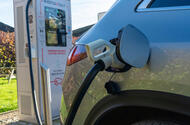Osprey CEO believes charging has been unfairly lumped in with the slump in demand for EVs
“If you’ve read the press in the last year or two, the constant headline has been that there’s not enough charging for electric vehicles. What has actually been happening on the ground in the last 18 months is a quite astonishing rollout of charging infrastructure.”
Ian Johnston, CEO of charging company Osprey, wants to change the narrative around the state of the charging network in this country.
He believes that charging has been unfairly lumped in with the slump in demand for the cars themselves. While gains in sales of EVs year-on-year have been marginal, Johnston told Autocar Business that the charging network has increased in size by 46% year-on-year and there are now more than 65,000 chargers operational in the UK. “And that rate and rollout is increasing all the time.”
He says charging companies like Osprey are focused on “funding and building this infrastructure ahead of the demand for EVs”, as whatever the peaks and troughs in demand for electric cars right now, the ultimate direction of travel and end game is clear.
Yet still, Johnston points to stigma and past truths about the charging network that could in turn be holding back the wider uptake of EVs.
“We’ve gone from a position of people worrying about queues or if a charger works, to now, in most cases, driving into big, high-power charging hubs,” says Johnston. He also pointed to the fact that consumers will no longer need multiple apps to pay for different chargers as standards are brought in to ensure a professional, reliable and easy-to-use service from the charging industry – with league tables showing the best and worst providers.
“The chargers installed in the last two years are reliable, easy to use, easy to pay; you just tap a bank card. The legacy chargers that are five, six or seven years old are such a tiny proportion of what’s in the ground.”
Johnston says it was “disappointing” and “so unnecessary” that the lack of charging was one of the reasons the previous government pushed the ban on the sale of non-electric cars back to 2035.
“But the good news is we’ve addressed one of the major reasons not to make the switch. We now just need the [new] government to work with industry to help generate more retail demand [for the cars themselves].”
The charging network could be expanding at an even faster rate if planning permissions and highway permits (to connect to high-voltage power supplies often already in the roads) are granted sooner. Johnston says there are thousands of charging installations across the industry in the pipeline, and the network could almost double in size again.
To that end, Johnston says the new government is already positively engaging with the network through dialogue with industry body ChargeUK.
“What’s great is that the early noises from the government have been that they’re really focused on fixing this as part of their drive to get Britain building again.
“This is not controversial infrastructure. We don’t have an issue with NIMBYs here saying please don’t build it; nearly everyone wants it. The problem is you’ve got to go through a process which is under-resourced and takes six to nine months to get planning permission.”
The charging industry is “not asking for money”, says Johnston, more an easier environment to operate in. Osprey alone is investing £40-50 million in installing new chargers and the total investment from companies into the charging sector stands at around £6 billion.
Much like the rush from car companies to launch new brands and products at huge losses in order to position themselves for future success in the next era, so too is there jostling among different charging companies to install networks at a loss, so as to be prepared for the projected demand increase.
The only money coming in is through the pence-per-kwh charged to a driver each time they charge, but even stripping out the return on investment on the installations themselves, the margins are still small as that revenue must cover the electricity cost to the supplier, as well as operational costs like call centres and servicing.
“It’s big money, proper business, but none of us are making a profit yet. The profit will come in the future.
“Today the main focus is just investing tens of millions every year on building infrastructure for when we get to our highest state of adoption. Today, we’re at 3% of the vehicles on the road as electric; 80-90% of those will have a home charger, but on average people are still charging at least once a month on the public network.
“We haven’t really even started seeing the true level of demand for charging. When that comes, that’s when the network’s will revert to profitability. But nobody’s making a profit here today at all.
Source: Autocar
